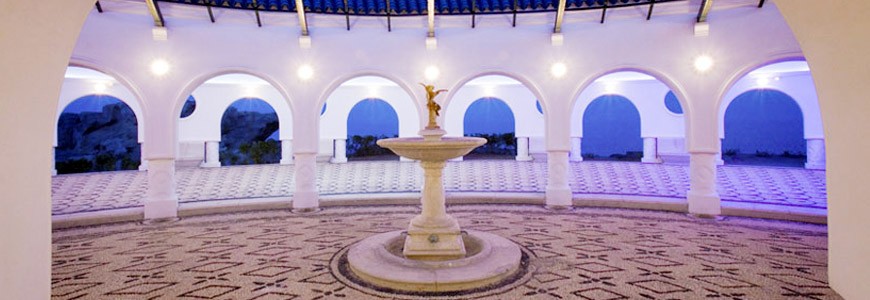Kalithea Spa
The springs of Kalithea have been known since ancient times. Rising in the eastern and central parts of the island of Rhodes, these legendary spa waters attract thousands of people every Year. Accompanied by their families, many hope to be cured of aliments by the healing water that spring from the rocks surrounding the bay of Kalithea.
The inhabitants of the island knew the therapeutic properties of the water and visited the area regularly. They stayed for some time at temporary dwellings they constructed themselves near the springs, in order to follow the traditional treatment that passed from generation to generation through the ages.
Everyone knew the rill of red water that sprang from a rock. Others stayed for as a long time as was required in the kouspes cavities in the rock that existed all over the area. This was a place where Orthodox, Moslems, and Jews, used to get together without any restrictions.
This miraculous spring has been known since the time of the Doric Hexapolis and the age of Knights and even beyond the limits of the island The inhabitants from acros the coast of Asia Minor and father deep in Anatolia came to visit the spring of Kalithea and stay there a long as it was necessary, especially in the clement month of September.
The area was known to the inhabitants of the nearby villages and the city as “Tsilonero“, (today is the bay of Kalithea and Faliraki) due the purgative qualities of the spring. From the begining of the 20th century, the temporary dwellings were replaced by camps,which developed as the years passed, especially by the inhabitants of the nearby Villages One of the first works for the arrangement of the Bay regarded the construction of a quay for the approach of little ships and tourist vessels.The physical features of the landscape, the rocks, the “Koupes” were preserved. The construction of the facilities began at the end of December 1928, by t the italian architect Pietro Lombardi.
The complex was arranged in three levels: From the main entrance,which was truly magnificent ,the visitor proceeded to a square open space ,with a circular fountaain and the stairs, which follow the ground relief .The second entrance leands to the main stairway and is flanked by columns that once supported a pergola covered with bougainvillea plants.
The stairway leads to the portico, on the right and on the left to circular facilities housing the laboratories and the offices,and further, to another stairway that ends, on the left and right,at the main Rotunda.
The building has a dome, 14 meters high elaborately, decorated and equipped with lozenge-shaped blue glass windows,that provide lighting. Under the Dome, the water of the spring flows from the six fountains into a circular cistern.The Rotunda has four staired entrances. Tow inscriptions are incised on the exterior and the interior part of the Building.
In 1930 the upper atrium was added and the open areas reached their final form. The architectural features of the building are a fine combination of all the different stages that Rhodian architecture went through.






